It’s 05:10, a thunderstorm has forced a rolling wave of delays, and your crew roster just went from “tight” to “impossible.” Captains are timing out, one reserve is out sick, and your WhatsApp thread looks like a stock ticker. This is when aviation crew scheduling software proves whether it’s window dressing—or your control tower for recovery.
In this guide, you’ll get a clear definition of aviation crew scheduling software, the features that matter in 2025, practical trade-offs by operator type, and a clean, ready-to-paste comparison table with Shifts by Everhour listed first. You’ll also learn a simple workflow to connect scheduling with time tracking so you can see scheduled-versus-actual reality, reduce overtime leakage, and protect compliance.
What Is Aviation Crew Scheduling Software?
Aviation crew scheduling software is a specialized system for planning and operating pilot and cabin crew rosters. Beyond “who flies what,” modern platforms:
- ✈️ Build legal pairings
- 🗓️ Create individual rosters
- ⏱️ Validate duty and rest rules
- 🎓 Track qualifications and training currency
- ⚡ Manage day-of-ops recovery when disruptions hit
Enterprise suites used by airlines often bundle crew pairing, rostering, tracking, and disruption management. Some also manage hotel and transport workflows or integrate natively with the operations control center (OCC) and flight ops systems.
Examples of airline-grade suites: Jeppesen Crew (Boeing), Sabre AirCentre Crew Manager, Lufthansa Systems NetLine/Crew, Airbus NAVBLUE N-OC (formerly RAIDO), AIMS, CAE (Merlot)

Why it matters in 2025
- 📋 Regulations and fatigue risk: Duty-time, rest, and qualification rules are stricter; software now checks compliance automatically
- 🌩️ Disruption recovery: Weather and ATC constraints require automated legality checks and “what-if” swaps to maintain service
- 📱 Mobile crew operations: Real-time notifications, roster acknowledgments, changes, and legality alerts keep crews aligned
- 💰 Cost and efficiency: Scheduled-vs-actual reporting drives payroll accuracy and reduces overtime and reserve misuse, improving margins
- 🔗 Data fabric: Integrations with OCC, flight ops, training, payroll, hotels, and transport keep the crew plan synchronized across the airline
Key Features, Trade-offs, and Use Cases
✈️ Crew pairing and rostering engines
What to look for: Optimizers for pairing (anonymous sequences) and rule-aware roster assignment by base, fleet, and qualifications. Support for multiple agreements (CBAs), seniority, and bidding preferences.
Use case: A multi-base carrier builds legal pairings and then produces seniority-aware rosters with minimal manual work while honoring rest and duty constraints. Jeppesen and CAE (Merlot) highlight these optimization workflows.
⚙️ Day-of-ops recovery and crew tracking
What to look for: Real-time legality checks as flights slip, rapid reassignments, automated reserve search, disruption handling, and alerting.
Use case: An inbound aircraft is late, pushing a captain over duty limits. The system surfaces legal reserves, alternative connections, and updated pairings in seconds. Sabre AirCentre and AIMS describe these operations capabilities.
😴 Fatigue and compliance safeguards
What to look for: Duty/rest windows, augmented crews, rapid legality validation when swapping flights, and audit logs for regulators.
Use case: A long-haul team adds an augmented pilot complement; the system validates legality and minimum rest automatically. Jeppesen and market overviews emphasize legality and rostering compliance.
🎓 Qualifications, training, and currency
What to look for: Type ratings, medicals, line checks, and recurrent training built into eligibility rules.
Use case: The software blocks assignments for lapsed medicals or expired door training and proposes legal alternatives. AIMS and CAE (Merlot) document training and currency tracking.
🏨 Hotel and transport integration
What to look for: Automated hotel and transport bookings driven by roster changes, with two-way status updates.
Use case: A weather diversion triggers new layover cities; hotel and transport interfaces update automatically for affected crew. Lufthansa Systems notes hotel and transport interfaces within NetLine/Crew.
📱 Mobile crew engagement
What to look for: Crew apps for duties, changes, acknowledgments, and push notifications, plus bid/preference inputs and off-duty visibility.
Use case: Cabin crew receive a mid-tour roster change on mobile and acknowledge instantly; legality checks fire before commit. CAE (Merlot)’s CrewMobile illustrates these flows.
🛩️ SMB and charter operations
What to look for: Lightweight planning, availability, time-off, and legality checks suitable for Part 91/135 and flight schools, often with integrated time tracking and simplified compliance.
Use case: A charter operator uses a combined roster/time system to assign duties across pilots and ground crew, then reconciles hours without exports. myairops flight and Shifts by Everhour both speak to smaller teams seeking speed and visibility.
Comparison Table: Aviation Crew Scheduling Software
| Tool | Key features | Pricing / plan | Ideal for |
|---|---|---|---|
| Shifts by Everhour | Drag-and-drop scheduling, open shifts & swaps, mobile apps, time tracking, scheduled vs actual reports | Free + Paid plans | Teams needing rosters & time tracking in one tool |
| NAVBLUE N-OC | Network scheduling, operations control, crew planning, day-of-ops scheduling | Enterprise licensing | Airlines needing end-to-end OCC & crew tools |
| Jeppesen Crew (Boeing) | Pairing & rostering optimization, legality/compliance, analytics | Enterprise licensing | Carriers prioritizing optimization & compliance |
| Sabre AirCentre Crew Manager | Scheduling, crew tracking, alerts, crew pay, disruption recovery | Enterprise licensing | Airlines focused on day-of-ops recovery & pay alignment |
| Lufthansa Systems NetLine/Crew | Full crew management, hotel/transport interfaces, comms tools | Enterprise licensing | Network carriers needing mature OCC & logistics workflows |
| AIMS Airline Software | Crew legality checks, reserve/standby search, hotel/travel, training, medical records, alerts | Enterprise / per-operator | Airlines & charters needing integrated legality & day-of-ops functions |
| CAE (Merlot) | Pairing/rostering, crew engagement app, mobile duties, currency tracking, cloud-enabled | Enterprise licensing | Airlines seeking cloud crew management & mobile engagement |
| myairops flight | Flight + crew management, duty time, personalized schedules, violation alerts | Subscription (SaaS) | Part 91/135, charter & bizav operators wanting flight + crew in one tool |
| Connecteam | Mobile scheduling, AI suggestions, crew communications | Free + Paid tiers | Ground or FA teams needing mobile-first scheduling & comms |
| AllRide Apps | Real-time availability, certifications, rest monitoring, rotation planning | Custom / consulting | Carriers exploring AI-forward or custom crew scheduling |
Summaries and Differentiators
Shifts by Everhour
Best fit when you need practical scheduling plus time tracking in one place for charter, training, MRO, and ground ops. It delivers scheduled-vs-actual visibility without exports, which shortens payroll prep and exposes overtime leakage.
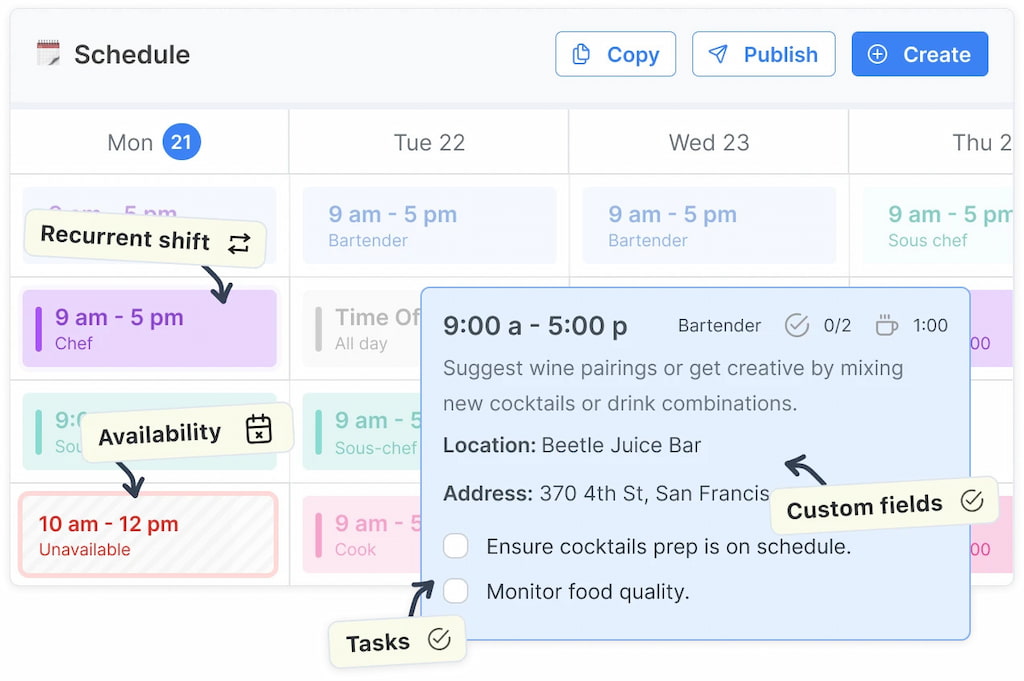
NAVBLUE N-OC
Airbus’s integrated flight ops + crew solution spans network scheduling, OCC, and day-of-ops crew scheduling—useful for airlines that want one backbone rather than stitched-together tools.
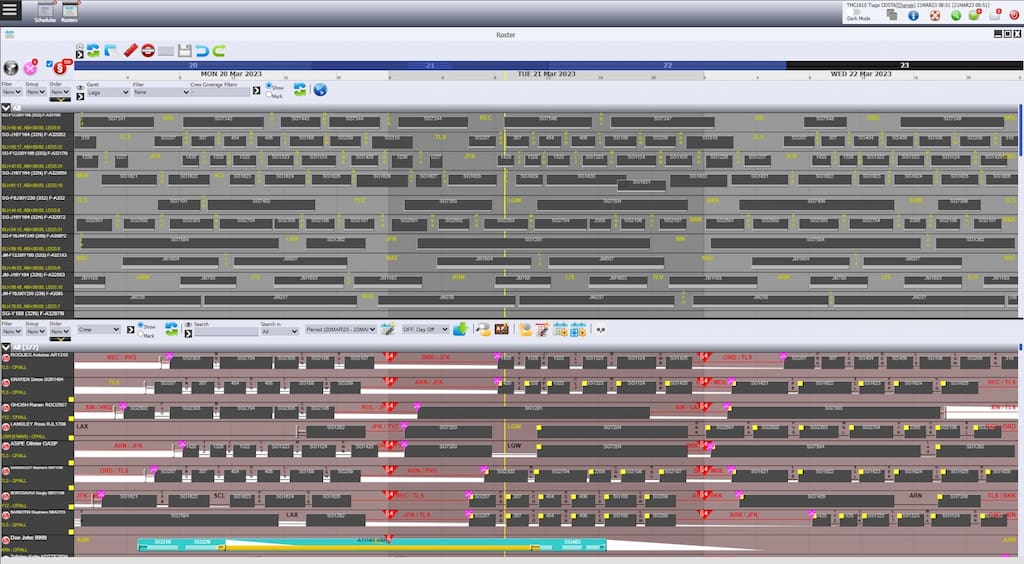
Jeppesen Crew
A longstanding leader in pairing and rostering optimization. Strong configuration and optimization engines aimed at cost control and large-scale complexity.
Sabre AirCentre Crew Manager
Emphasizes operations—tracking, notifications, pay alignment, and disruption recovery—so day-of-ops teams can keep flights legal and moving.
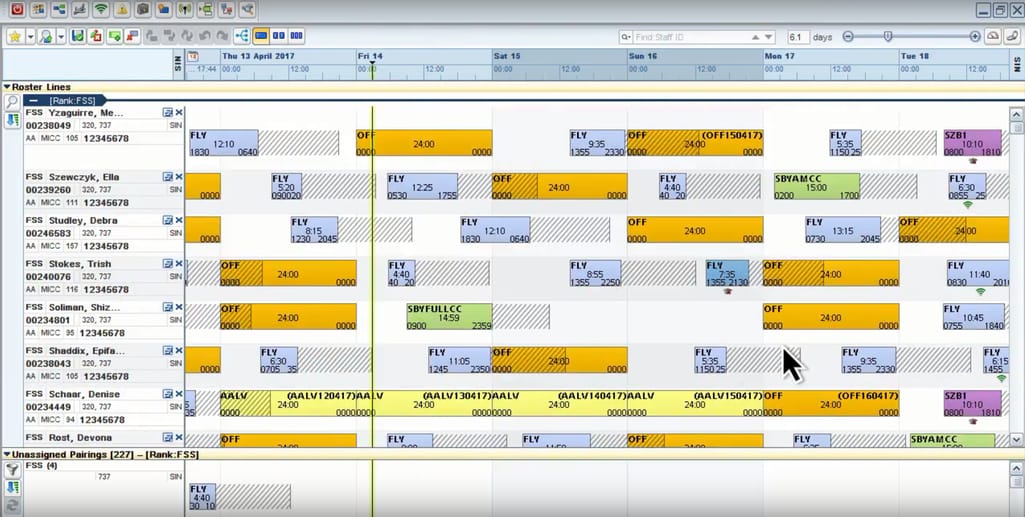
Lufthansa Systems NetLine/Crew
Full-cycle crew management with airline-grade interfaces, including hotel and transport automation for layovers and disruptions.
AIMS Airline Software
Known for legality/coverage checks, reserve optimization, and integrated hotel/travel and training records—popular with airlines and large charters.
CAE (Merlot)
Cloud-enabled crew management with a mobile app that supports duty acknowledgments, changes, and notifications; strong pairing and rostering lineage.
myairops flight
Flight management plus crew rostering in a SaaS package; focuses on duty time, violation visibility, and an updated crew app experience for bizav/charter.
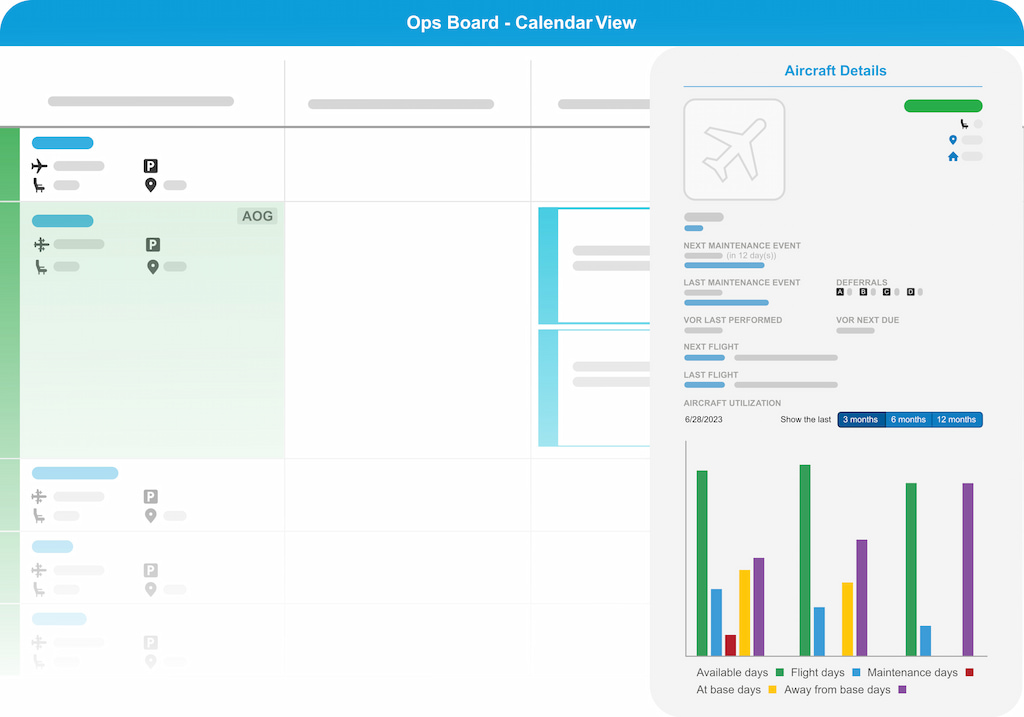
Connecteam
A general crew scheduling and communications app that can help ground teams and flight attendants with mobile schedules, swaps, and alerts.
![the 9 best when i work alternatives in 2023 [both paid and free]](https://blog-cdn.everhour.com/blog/wp-content/uploads/2023/01/connecteam.jpg)
AllRide Apps
Marketing emphasizes real-time availability, certification checks, and rotation balance; positioned for AI-driven builds and airline workflows.
Where Shifts by Everhour Fits
Crew scheduling and workforce management often overlap in aviation — especially for charter operators, flight schools, MRO shops, ground handlers, and FBOs. Shifts by Everhour is built for shift-based operations, letting you create and publish schedules, manage open shifts and swap requests, and track time in one place.
🧭 A practical flow
- Structure and templates – Define locations (bases, hangars, terminals), roles (captain, FO, FA, ramp, line maintenance), and save recurring duty patterns as templates.
- Publish and self-serve – Post schedules two weeks out, allow open shifts and swaps with approval, and reduce manual coordination.
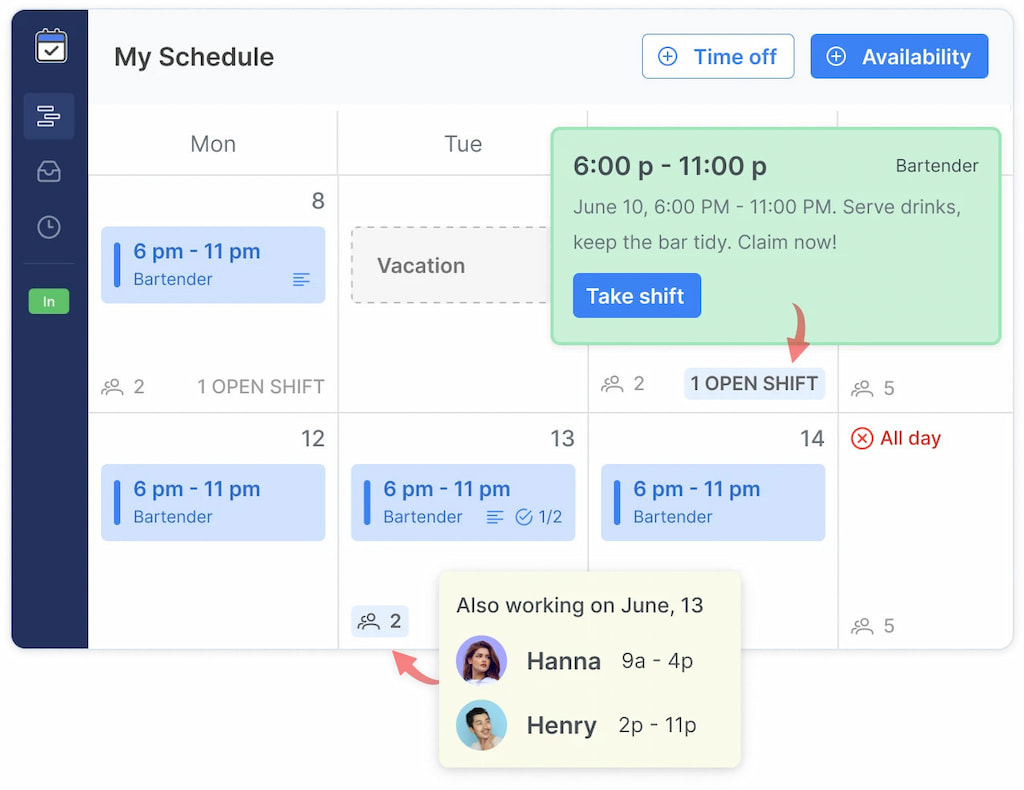
- Clock and reconcile – Crew and ground teams clock in/out via mobile or kiosk, while managers compare scheduled vs actual hours and flag exceptions.
- Improve with data – Monitor KPIs like overtime, build time, swap lead time, and coverage gaps to refine staffing.
If you operate at airline scale, your shortlist will still include enterprise suites like Jeppesen, Sabre, NetLine/Crew, NAVBLUE N-OC, AIMS, and CAE (Merlot).
But for charter, training, MRO, ground services, or smaller operators, Shifts by Everhour’s unified scheduling-plus-time model brings visibility and ROI without the overhead of complex systems.
Best Practices and Field-Tested Tips
📅 Publish on a cadence
Release new schedules on a consistent day and time (for example, every Thursday at 16:00). Predictability builds trust and reduces last-minute swaps.
⚙️ Codify your constraints
Define rest windows, max duty limits, qualifications, and reserve rules directly in your scheduling tool. Keep them updated as CBAs or internal policies evolve.
⏱ Use short overlap buffers
Add 15–30 minutes of handover where operations depend on seamless transitions — like turnarounds or first-wave prep. It’s cheaper than a missed connection.
🚀 Open shifts before panic
Post open duties 48–72 hours in advance. Qualified crew can self-assign quickly, saving schedulers from last-minute calls.
🧾 Treat changes like transactions
Require confirmations for all critical duty changes and maintain a digital audit trail. It protects both safety and payroll accuracy.
🔍 Run monthly post-ops reviews
Compare scheduled vs actual performance, look for overtime or no-show trends, and adjust templates to prevent repeat issues.
FAQ: Aviation Crew Scheduling Software
What’s the difference between airline-grade crew systems and generic schedulers?
Airline-grade systems add pairing optimization, legality checks, training/qualification rules, day-of-ops recovery, and integrations with OCC, hotels, and transport. Generic schedulers focus on shifts and communications, not flight-specific legality and network disruption.
Can smaller operators skip enterprise suites?
Often, yes. Charter operators, flight schools, and ground services can benefit from lighter tools that combine scheduling with time tracking—like Shifts by Everhour—or from aviation-focused SaaS like myairops flight. Your complexity and regulatory environment should drive the choice.
How do fatigue and legality checks actually work in software?
The system encodes duty/rest rules, augment options, and local regulations. As you build pairings or swap duties, the engine validates legality and flags violations before publish. Leading vendors foreground these controls in pairing/rostering modules.
Do these platforms handle hotels and transport?
Some do. Lufthansa Systems’ NetLine/Crew, for example, offers interfaces that automatically reserve rooms and transport based on roster activity—critical in irregular operations.
How quickly can we see ROI?
Teams that reduce overtime and scheduling admin often see improvements within two to three payroll cycles. Track a baseline (overtime hours, schedule build time, swap lead time) and compare after rollout. [Insert verified stat]
Final Thoughts
The right aviation crew scheduling software acts like a second OCC—predictive before disruption and decisive when it hits. For airline-scale networks, shortlist enterprise suites that unify pairing, rostering, legality, and day-of-ops recovery. For charter, training, MRO, and ground ops, the combination of scheduling and time tracking in Shifts by Everhour can deliver fast, visible ROI without the overhead of an airline-grade suite.
If managing time or shifts is your daily challenge, try Everhour. If you’re scaling airline operations and need pairing, legality, and day-of-ops recovery in one backbone, review the enterprise tools above and run a pilot with clearly defined KPIs.
Check out the best employee roster software to make sure every minute is counted!

